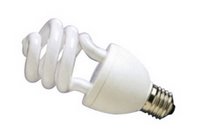
I hear this too often. Usually it is about the time when the conversation turns towards conserving national energy by starting at home. It's just one house or it's just one lawn or it's just one light...What good will it do?
Let us take a look at the light bulb. Wonderful invention that paved the way for so much of what we see in society (especially at night time
A few years back compact fluorescent bulbs became inexpensive. Sure they are still as expensive as buying several bulbs but they can last you for years, if you treat them properly. Treating them properly means that you do not turn them off if you know that you will be turning it back on in 15 minutes, just like a regular fluorescent bulb.
What good will it do?
Consider the following:
Replacing one incandescent lightbulb with an energy-saving compact fluorescent bulb means 1,000 pounds less carbon dioxide is emitted to the atmosphere and $67 dollars is saved on energy costs over the bulb's lifetime. (U.S. Environmental Protection Agency and Alliance to Save Energy)
I found the quote here.
Energy Star has this to say about compact fluorescent bulbs.
If every household in the U.S. replaced one light bulb with an ENERGY STAR qualified compact fluorescent light bulb (CFL), it would prevent enough pollution to equal removing one million cars from the road. CFLs provide high-quality light, smart technology, and design, requiring less energy while lasting longer than typical incandescent bulbs.
Now one thing to be mindful of is that CFLs have trace amounts of mercury in them. Therefore, you should follow these disposal guidelines (provided by CFLBulbs.com):
Dispose of expended or broken CFL's at your local Household Hazardous Waste (HHW) Collection Site. If your local HHW Collection Site does not accept CFLs, check with local authorities. Many CFL retail outlets also offer safe disposal or recycling. Find information on your local HHW site at: earth911.org.
Do you have a youngster that is still within the K-12 school range? Then check out Mr Luna's Bright Idea blog.
An article that focuses on what person, one house, or one company can do to help reduce emissions and reduce dependence on coal.
What if everyone in America changed light bulbs to compact fluorescent bulbs in their home? We could stop mountaintop removal and start cleaning up our air and water today.
Energy cost-saving ideas for businesses are everywhere. We did a study that found that one factory could save $40,000 per year just by turning off computer monitors at night. Businesses can also install programmable thermostats to change the temperature in the office automatically after hours. Properly located motion-detecting light switches can turn lights off and on automatically when people are present - think of all the applications for classrooms, offices, and rest rooms.
Just to let you know the other side, here is a quick list of cons concerning this type of lighting, as taken from here.
1) Do not instantly produce light.
2) Do not like hot environments
3) Do not like wet locations
4) Initially cost more
5) Most can not be used with light dimmers
6) May not fit into some light fixtures
I have to admit that it does take a couple of minutes for my backyard yellow CFL to get to maximum brightness. No biggie since I will usually have to turn it on, gather what I need to take outside, and then actually head out the door.
Did you know that there are CFLs out there that will also help remove odors from a room? Check out fresh 2. I have no idea if their claims are straight up since I do not own one but I do admit that it has my curiousity piqued.
Graphic for this article was taken from SaverPlus Lighting, please check out their website and no, they did not pay for the advert. ;)
| technorati tags: CFL Bulbs, lighting, conservation, environment,energy, flourescent |